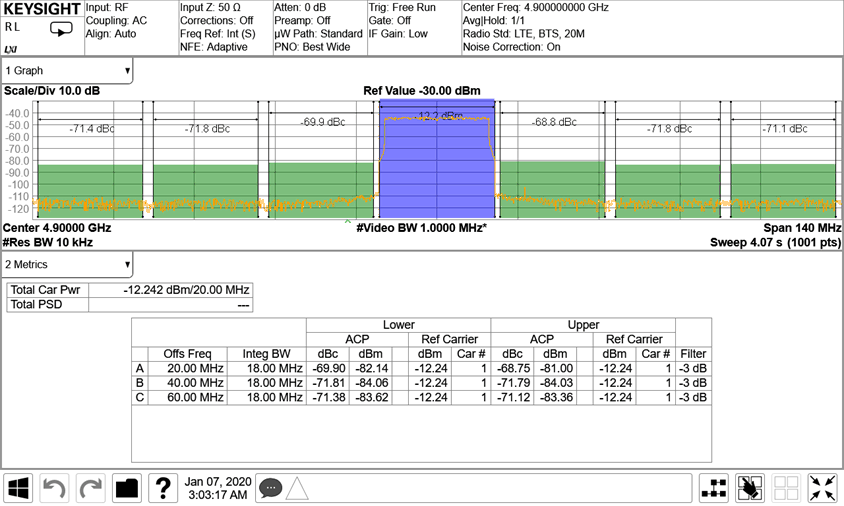Typical values at TA = +25°C with
nominal supplies. Default conditions: TX input data rate = 491.52MSPS,
fDAC = 11796.48MSPS (24x interpolation), interleave mode,
1st Nyquist zone output, PLL clock mode with fREF =
491.52MHz, AOUT = –1dBFS, DSA = 0dB, Sin(x)/x enabled, DSA calibrated

| Excluding PCB and cable losses,
Aout = -0.5 dFBS, DSA = 0, 4.9GHz
matching |

| fDAC = 11796.48MSPS,
Aout = -0.5dFBS, matching 4.9GHz |
|

| fDAC =11796.48MSPS, interleave
mode, matching at 4.9GHz |
| Differential Gain Error = POUT(DSA Setting – 1) – POUT(DSA Setting) + 1 |

| fDAC = 11796.48MSPS, interleave
mode, matching at 4.9GHz |
| Integrated Gain Error = POUT(DSA Setting) – POUT(DSA Setting = 0) + (DSA Setting) |

| fDAC = 11796.48MSPS, interleaved
mode, matching at 4.9GHz |
| Differential Gain Error = POUT(DSA Setting – 1) – POUT(DSA Setting) + 1 |

| fDAC = 11796.48MSPS, interleaved
mode, matching at 4.9GHz |
| Integrated Gain Error = POUT(DSA Setting) – POUT(DSA Setting = 0) + (DSA Setting) |

| fDAC = 11796.48MSPS, interleaved
mode, matching at 4.9GHz |
| Differential Phase Error = PhaseOUT(DSA Setting – 1) – PhaseOUT(DSA Setting) |
| Phase DNL spike may occur at any DSA setting. |

| fDAC = 11796.48MSPS, interleaved
mode, matching at 4.9GHz |
| Integrated Phase Error = Phase(DSA Setting) – Phase(DSA Setting = 0) |

| fDAC = 11796.48MSPS, interleaved
mode, matching at 4.9GHz |
| Differential Phase Error = PhaseOUT(DSA Setting – 1) – PhaseOUT(DSA Setting) |

| fDAC = 11796.48MSPS, interleaved
mode, matching at 4.9GHz, channel with the median
variation over DSA setting at 25°C |
| Integrated Phase Error = Phase(DSA Setting) – Phase(DSA Setting = 0) |

| fDAC = 11796.48MSPS, interleaved
mode, matching at 4.9GHz, fCENTER = 4.9GHz,
-13 dBFS each tone |

| fDAC = 11796.48MSPS, interleaved
mode, matching at 4.9GHz, fCENTER = 4.9GHz,
–13 dBFS each tone, worst channel |

| Matching at 4.9GHz, Single tone,
fDAC = 11.79648GSPS, interleave mode,
40MHz offset, DSA = 0dB |

| Matching at 4.9GHz, single carrier 20MHz BW
TM1.1 LTE |

| Matching at 4.9GHz, single carrier 20MHz BW
TM1.1 LTE |

| Matching at 4.9GHz, fDAC =
11.79648GSPS, interleave mode, normalized to output
power at harmonic frequency |

| fDAC = 11796.48MSPS, interleave
mode, 4.9GHz matching, includes PCB and cable losses.
ILn = fS/n ± fOUT. |

| fDAC = 11796.48MSPS, interleave
mode, 4.9GHz matching, includes PCB and cable losses.
ILn = fS/n ± fOUT. |

| Excluding PCB and cable losses,
Aout = -0.5 dFBS, DSA = 0, 4.9GHz
matching |

| fDAC =11796.48MSPS, interleave
mode, matching at 4.9GHz |
| Differential Gain Error = POUT(DSA Setting – 1) – POUT(DSA Setting) + 1 |

| fDAC =11796.48MSPS, interleave
mode, matching at 4.9GHz |
| Integrated Gain Error = POUT(DSA Setting) – POUT(DSA Setting = 0) + (DSA Setting) |

| fDAC = 11796.48MSPS, interleaved
mode, matching at 4.9GHz |
| Differential Gain Error = POUT(DSA Setting – 1) – POUT(DSA Setting) + 1 |

| fDAC = 11796.48MSPS, interleaved
mode, matching at 4.9GHz |
| Integrated Gain Error = POUT(DSA Setting) – POUT(DSA Setting = 0) + (DSA Setting) |

| fDAC = 11796.48MSPS, interleaved
mode, matching at 4.9GHz |
| Differential Phase Error = PhaseOUT(DSA Setting – 1) – PhaseOUT(DSA Setting) |

| fDAC = 11796.48MSPS, interleaved
mode, matching at 4.9GHz |
| Integrated Phase Error = Phase(DSA Setting) – Phase(DSA Setting = 0) |

| fDAC = 11796.48MSPS, interleaved
mode, matching at 4.9GHz |
| Differential Phase Error = PhaseOUT(DSA Setting – 1) – PhaseOUT(DSA Setting) |

| fDAC = 11796.48MSPS, interleaved
mode, matching at 4.9GHz |
| Integrated Phase Error = Phase(DSA Setting) – Phase(DSA Setting = 0) |

| fDAC = 11796.48MSPS, interleaved
mode, matching at 4.9GHz, POUT = –13
dBFS |
|
|

| fDAC = 11796.48MSPS, interleaved
mode, matching at 4.9GHz, fCENTER = 4.9GHz,
–13 dBFS each tone |

| fDAC = 11796.48MSPS, interleaved
mode, matching at 4.9GHz, fCENTER = 4.9GHz,
fSPACING = 20MHz |

| TM1.1, POUT_RMS = –13dBFS |

| Matching at 4.9GHz, single carrier 20MHz BW
TM1.1 LTE |

| Matching at 4.9GHz, single carrier 20MHz BW
TM1.1 LTE |

| Matching at 4.9GHz, fDAC =
11.79648GSPS, interleave mode, normalized to output
power at harmonic frequency |
|

| fDAC = 11796.48MSPS, interleave
mode, 4.9GHz matching, includes PCB and cable losses.
ILn = fS/n ± fOUT. |


































